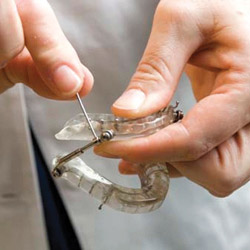
Our country is sleep-deprived—desperate for restful nights, to awaken easily and be functional throughout the day without needing a nap. The anxiety and stress of our busy world certainly make it difficult to fall asleep and stay asleep. But those dreams of feeling rested are even more difficult to achieve when nights are fraught with the tossing, turning, snoring, choking or gasping for breath by oneself or a bed partner.
Medical research has determined that approximately 50 million Americans suffer from some form of sleep disordered breathing (SDB) every night, but fewer than 10 percent have been diagnosed.
Sleep disordered breathing is a serious health problem, and its first appearance is usually indicated by snoring. Although snoring is generally viewed as a minor annoyance—something to be ignored or blocked out—it can be the first sign of a problem.
Untreated sleep disorders have been associated with obesity, cardiovascular disease, high blood pressure, diabetes, acid reflux, depression, ADHD in children and a host of other problems—and it can be fatal. SDB ranges in severity from snoring to upper airway resistance syndrome to obstructive sleep apnea, where the serious and often life-threatening problems begin.
Traditional Treatment
Continuous Positive Airway Pressure (CPAP) has continued to be the “gold standard” of treatment for obstructive sleep apnea. If a patient is using CPAP and doing well, they should stay on it. Unfortunately, many patients simply cannot get used to the masks, or suffer from claustrophobia that causes them to discontinue wearing the mask. According to the American Sleep Apnea Association, approximately 60 percent of CPAP users are still using the CPAP after a few months. If a patient cannot wear the CPAP, other treatment options include lifestyle changes, surgery and oral appliance therapy.
Oral Appliance Therapy
Oral appliance therapy (OAT) has come to the forefront as a very viable, scientifically-based treatment option for obstructive sleep apnea. The American Academy of Sleep Medicine issued a statement in the 2006 journal, SLEEP, declaring that oral appliance therapy is an excellent treatment option for those suffering from mild to moderate obstructive sleep apnea, and is proving to be affective for severe cases as well. The purpose of the oral appliance is to hold the jaw in a position that allows the airway to remain as open and firm as possible during sleep. Oral appliances are similar to athletic mouth guards, but are less bulky and completely non-invasive.
Physicians and Dentists Working Together
Dentists across the country have teamed up with physicians and other specialists, cooperating in an important relationship to identify and manage sleep disordered breathing patients interested in oral appliance therapy. Patients can use the following steps in pursuing treatment:
- Finding a sleep disorders dentist. The first step is to find a dentist who is trained and experienced in the overall care of oral health, the tempormandibular joint, dental occlusion and associated oral structures. The American Academy of Dental Sleep Medicine (aadsm.org) and the Academy of Clinical Sleep Disorders Dentistry (acsdd.org) are helpful sources in finding a dentist with these qualifications.
- Screening for sleep apnea. If a patient has not been previously diagnosed with obstructive sleep apnea, the dentist will screen for sleep apnea using simple questionnaires, health histories, weight, body mass index (BMI) calculations and neck circumference measurements, as well as oral and airway evaluations.
- Home sleep test or overnight lab sleep test. If a patient shows the markers for OSA, he or she will need to obtain a sleep study. Depending on the patient’s health history, the dentist will offer an at-home sleep test or an overnight-attended test called polysomnography. These tests are read by a board-certified sleep physician who will determine a diagnosis. It is important to know if the patient is considered mild, moderate or severe in order to be able to recommend the proper treatment therapy.
- Fitting the oral appliance. If the patient is then a candidate for OAT, the dentist will take a custom impression and bite in order to have an FDA-approved lab fabricate the oral appliance.
- Follow-up care. Progress is monitored carefully, as each patient has a different airway and requires specific titration, which means the appliance is slightly modified according to the patient's specific bone and teeth structure. When a patient feels that their snoring has stopped and their symptoms have been relieved, a follow-up sleep study will be performed with the oral appliance in place. Once maximum medical efficacy is reached, the dentist will see the patient again in six months, and then yearly after that. This gives the dentist the ability to ensure continued treatment success and make modifications to the treatment regimen as needed.
Obstructive sleep apnea is a serious medical condition and is covered by most medical insurances and Medicare. iBi
For more information regarding oral appliance therapy, call (309) 243-8980 or visit IllinoisSleepDoc.com.
» Advantages of Oral Sleep Appliances
- Covered by most medical insurances and Medicare
- Most people acclimate quickly to wearing an oral appliance
- Patients who cannot tolerate or refuse to use a CPAP now have a non-surgical alternative
- Oral appliances are small, convenient and easy to carry when traveling
- Bed partner accepted, discreet and quiet
- Can be used with other therapies for increased benefits.

